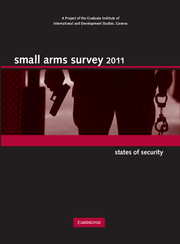Book contents
- Frontmatter
- Foreword
- Contents
- About the Small Arms Survey
- Notes to readers
- Acknowledgements
- Introduction
- Chapter 1 Larger but Less Known: Authorized Light Weapons Transfers
- Chapter 2 Fact or Fiction?: The UN Small Arms Process
- Chapter 3 Procurement and Policy: Police Use of Emerging Weapons Technology
- Chapter 4 A Booming Business: Private Security and Small Arms
- Chapter 5 Protected but Exposed: Multinationals and Private Security
- Chapter 6 Ethos of Exploitation: Insecurity and Predation in Madagascar
- Chapter 7 Reforming the Ranks: Public Security in a Divided Côte d'Ivoire
- Chapter 8 Securing the State: Haiti before and after the Earthquake
- Chapter 9 Balancing Act: Regulation of Civilian Firearm Possession
- Index
Chapter 7 - Reforming the Ranks: Public Security in a Divided Côte d'Ivoire
Published online by Cambridge University Press: 05 March 2012
- Frontmatter
- Foreword
- Contents
- About the Small Arms Survey
- Notes to readers
- Acknowledgements
- Introduction
- Chapter 1 Larger but Less Known: Authorized Light Weapons Transfers
- Chapter 2 Fact or Fiction?: The UN Small Arms Process
- Chapter 3 Procurement and Policy: Police Use of Emerging Weapons Technology
- Chapter 4 A Booming Business: Private Security and Small Arms
- Chapter 5 Protected but Exposed: Multinationals and Private Security
- Chapter 6 Ethos of Exploitation: Insecurity and Predation in Madagascar
- Chapter 7 Reforming the Ranks: Public Security in a Divided Côte d'Ivoire
- Chapter 8 Securing the State: Haiti before and after the Earthquake
- Chapter 9 Balancing Act: Regulation of Civilian Firearm Possession
- Index
Summary
INTRODUCTION
On the eve of 2011, Côte d'Ivoire plunged into yet another deep political crisis. On the streets of Abidjan, the internationally recognized winner of the November 2010 presidential elections, former prime minister Alassane Ouattara, took refuge in the Golf Hotel. The incumbent, Laurent Gbagbo, occupied the Presidential Palace, refusing to step down, while repeated clashes between security forces and political supporters in the capital claimed close to 200 lives in December 2010 (Munzu, 2011). The country ushered in the new year with two governments conducting business in parallel and operating in an atmosphere of mutual hostility and violence.
Among the factors influencing the wave of post-election violence is the failure to implement the security provisions of the 2007 Ouagadougou Political Agreement (OPA). The disarmament and demobilization of the rebels and the proruling party militias, scheduled for completion two months prior to the elections, were far behind schedule. Meanwhile, the Integrated Command Center (ICC), a combined government-rebel force designed to serve as a pilot for the future ‘New Army’ and to provide security during the electoral process, has remained symbolic in nature, to the point that its existence is seriously jeopardized by the current political crisis.
- Type
- Chapter
- Information
- Small Arms Survey 2011States of Security, pp. 193 - 228Publisher: Cambridge University PressPrint publication year: 2011



